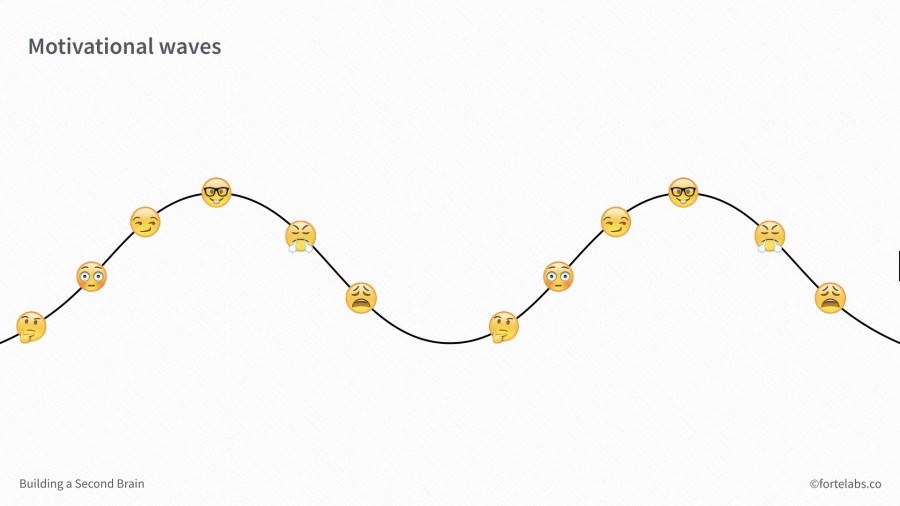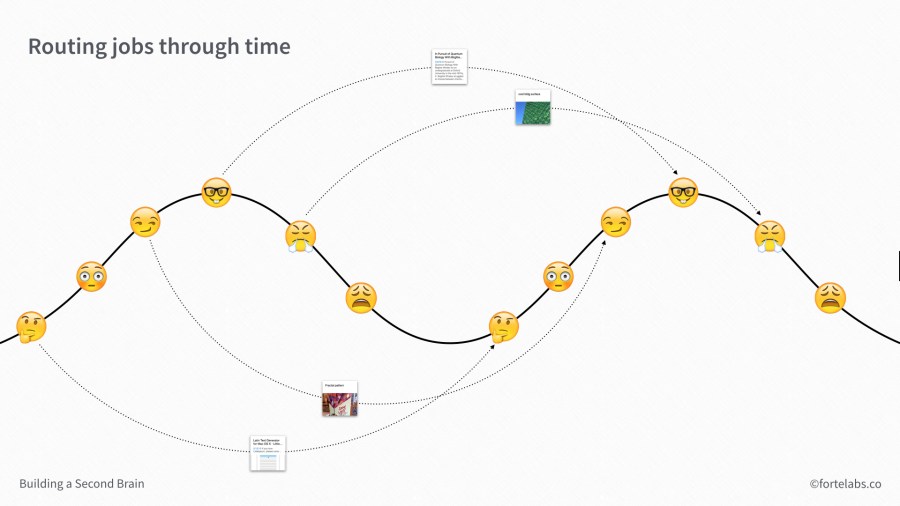
In Part 17, I argued that unique states of mind are the most powerful resource available to knowledge workers. But these states are difficult to reproduce on demand, and come and go unpredictably.
Our challenge becomes clear: how do we capture the value from a series of valuable, yet fleeting mental states?
Let’s take the following states of mind for example:
Note that each of these states favors a certain kind of activity, which produces a unique kind of value:
- Mischievous cleverness would be good for hacking a piece of software to do what you want
- Geeking out is good for late night projects tinkering in the garage
- Appalled incredulity can inspire wonderful reserves of anger and motivation toward a goal
- Righteous indignation is very useful for writing passionate thought pieces arguing for a change you care about
- Melancholy has long been used by artists to tap into deep reserves of creativity
- Motivated curiosity is great for exploring a rabbit trail through Wikipedia to try and understand an idea
Because our ability to produce these states on demand is limited, it can be a challenge to capture the value they create, and use it to build something durable. You might sign up for an online course late at night in the excitement of the moment, but the next morning, you wake up in a state of mind so different you might as well be a different person.
Human attention is not designed to pay close attention to anything for very long. It flits and flutters like a bird, constantly alighting on the newest and shiniest thing. This isn’t a character flaw – it is a valuable evolutionary adaptation that has allowed your genes to survive through the generations.
Luckily, there is one feature of these states we can take advantage of. Their arrival isn’t completely random – they come in motivational waves.
Why waves?
Because humans are wired for rhythm. Everything we do and experience is in cycles: waking and sleeping, menstruation, blood circulation, blinking, pulse, hormonal secretions, heart rate, thermoregulation, bowel activity, nostril dilation, appetite, and arousal, among many others.
The same goes for states of mind: they are loosely tied to certain times of day, environments, and events, including the ebb and flow of our work. You might often experience excitement and energy in the early stages of a project, and anxiety and stress in later stages (or for some people, vice versa).
Why motivational?
Because for our purposes, the most important feature of these cycles is that they strongly bias us toward certain kinds of activities. Motivation is not a single phenomenon that is either “high” or “low.” Motivation has a direction. Performing a task in line with your motivation is easy and satisfying (reading a book when I’m feeling quiet and introspective), whereas trying to go against my motivation is difficult and frustrating (reading a book when I’m feeling social or scatterbrained).
Instead of trying to force our state of mind to fit the task at hand, we can change the task at hand to fit our state of mind. This has only become possible in recent years, as most knowledge workers have gained tremendous autonomy in how, when, where, and on what to work on.
At the peaks, we are activated and energetic and can produce enormous amounts of value in short periods of time. But we are not often at our peak. To maximize our impact and performance, we need to learn how to make use of the valleys as well.
Because both the peaks and valleys arrive with some regularity, we can “assign” tasks and projects to the state of mind most suitable for completing them. This is the job of a Project Portfolio Manager: understanding both the tasks and the workers well enough to route the right job to the right person at the right time. Except now the “workers” are your states of mind across time, instead of other people.
Emotional agility
In the 1990s, Daniel Goleman revolutionized our understanding of workplace performance with his book Emotional Intelligence. His argument was radical and profound: that it is emotional intelligence, not just analytical intelligence, that determines a person’s success and happiness.
But emotional intelligence still implies that this intelligence is of one kind, and that more is better. I believe we’re entering a new era in which it is emotional agility that matters most.
As the leader and manager of your own business (even if it’s a business of one), you have to wear many hats: operations, customer service, sales, production, management, strategy, and creative, among many others. What’s challenging about this is not just the knowledge and skills associated with each one. It is the ways of being required for each of them.
To land a sale, you’ll need to take on a way of being that is generous, expansive, and confident. How quickly can you pivot from there to focus mode, which requires a way of being that is critical and self-questioning? How seamlessly can you jump from lone wolf on one project, to team player on another? How much agility do you have moving between intellectual rigor, and vulnerability?
The risk of too much “deep focus” is that we make ourselves into one-track minds. We dampen the variability and uncertainty in our lives to get more done, but as a side effect also remove the spontaneity and serendipity that make life worth living.
What we need is a way of working that breaks the tradeoff that we are faced with today as knowledge workers: make a dent in the universe OR live a happy, balanced life. By building a second brain, we have a system for turning the flow of random ideas into stocks of valuable knowledge.
The waves of motivation we experience become opportunities instead of threats. With our second brain totally focused on its objective, our first brains are free to flow.
Follow us for updates on Twitter, Facebook, Instagram, LinkedIn, or YouTube.
The Only Subscription
You Need to
Stay at the
Edge of AI
The essential toolkit for those shaping the future
"This might be the best value you
can get from an AI subscription."
- Jay S.
Join 100,000+ leaders, builders, and innovators

Email address
Already have an account? Sign in
What is included in a subscription?
Daily insights from AI pioneers + early access to powerful AI tools











Comments
Don't have an account? Sign up!